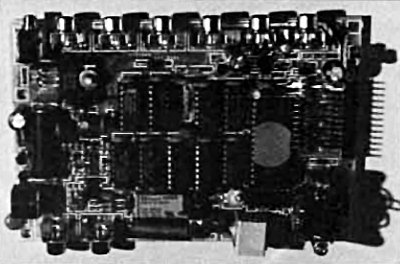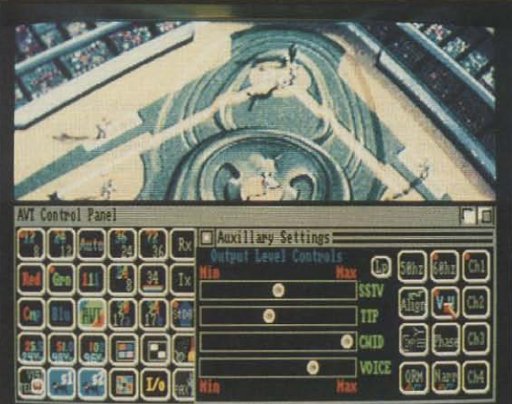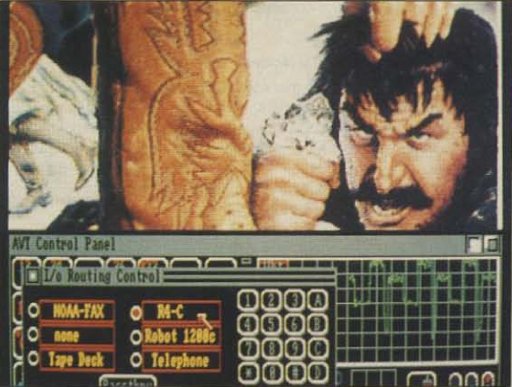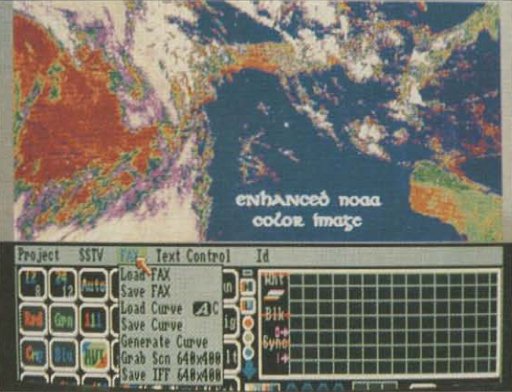Amiga AVT System
Advanced Electronic Appli cations PO Box C-2 160 Lynnwood, WA 98036 Price Class: $300
Slow-scan TV (SSTV) has been a specialty in ham radio, practiced by a small group fascinated by the idea of sending video images worldwide on the HF bands. The practice of this mode, however, has been plagued by many problems—the expense of dedicated equipment, the susceptibility of the image to band noise and interference, and the lack of frame resolution, to name a few. The subject of this review, however-the Amiga AVT interface, conceived by Ben Blish N4EJI—uses digital techniques for dealing with slow-scan signals and images with astonishing results ... de NS1B

Photo A. The AVT Interface board.
- Are you considering trying slow-scan television (SSTV)?
- Would you like to receive FAX images for weather and news?
- Do you think that SSTV is not worth the time, energy, or radio spectrum?
- Are you looking into buying a new computer for business, home, and/or shack?
- All of the above?
- None of the above?
Even if you answered "F" 10 th is simple multiple-choice questionnaire, you owe it to yourself to read on!
Life After 20m SSB
Hams with the least amount of curiosity can't help but want to experiment with exotic modes, such as FAX and SSTV. We soon hear, however, how expensive and timeconsuming it can be to get involved with them. We couldn't afford, nor talk our wives into, buying equipment dedicated to SSTV or FAX.
Renewed hope came along with the growing availability of personal computer systems. This was something the whole family could use. Most PCs. however, are not designed for high quality graphic output One recent newcomer is a dramatic exception...
The Amiga Computer
In 1985, Commodore Business Machines introduced a new computer using a microprocessor capable of true 16-bit addressing. This computer had the most advanced graphic co-processors of the time and true multitasking capability. Multitasking is the capability of a computer to run two or more programs concurrently. (Programs "time-share" the CPU in tightly-timed cycles.) This was a breakthrough for personal computers.
The Amiga is capable of running MS-DOS programs, so I could upgrade to the Amiga and still use my PC software. With a few inexpensive add-ons. I can run C-64 or Macintosh software. Because of multitasking. I could, for example, operate packet on the PC side and use my word processor on the Amiga side at the same time. The packet information can be saved as an MS-DOS file that I could use in my documents on the Amiga.
The Amiga's true NTSC composite video allowed animation, character generation, and high quality image art output to my VCR. I taped weddings, hamfests, and company picnics, and added graphics and titles to my home VCR movies. This $1600 investment —which comprised an Amiga A2000 microcomputer with a floppy drive and 1 megabyte of memory, color monitor. and mouse—really turned out to be useful for the entire family!

Photo B. The AVT control panel, on lower half of photo.

Photo C. The AVT control panel with I/O window open, The six icons on the screen are coupled to the six input jacks on the A VT interface board.
A Look at SSTV
Using the Amiga for SSTV had real promise, since I had a nice HF setup. I could get involved with my computer graphics and my radio at the same time, without adding another large expense to the already well-working station. There was still, however, a missing link—an interface that would take video signal data from a receiver and give it to the Amiga in a form it could deal with.
Enter The AVT Interface
The answer came in late 1988. when a group of software and hardware developers, headed by Ben Blish N4EJJ. created the Black Belt System "AVT." The hardware is a 3-inch by 5-mch printed circuit board that interfaces between the audio section of the receiver and the parallel port on the Amiga. The software is on a 3,5 inch (880 KB) floppy diskette. The user furnishes a 12 VDC power source, a connection to receiver audio, and an interconnecting cable from the Amiga's digital sound port to the transmitter input. The AVT software requires an Amiga with a megabyte of random access memory (RAM). A color monitor is suggested, but not required.
The Amiga is very user-friendly. I was impressed at how easy it was for me to get the system up and running. The Black Belt System software takes full advantage of the graphic icon-based user interface. That is, a menu that uses graphics to show choices appears on-screen, and you can move around this menu and make choices with a pointer moved by a small table-top controller called a “mouse.“
AVT vs. Conventional SSTV Modes
The major advantages of the AVT modes over conventional SSTV modes are:
- Images always maintain color accuracy.
- Images always maintain horizontal and vertical position,
- Images always start at the top of the display.
- More efficient use of the radio spectrum, •The narrow bandwidth allows use of filters and blanker.
- More effective use of the transmitting equipment.
- High and super-high resolutions with black and white/color/3D capability.
- Fully automatic operation.
- Full support to the ARexx interface language.
The first thing I noticed when I got the sys tem up and running was the AVT buttons for 24-second, 90-second, 94-second and 400-pixel modes. The 24-second and 90-second video modes are much like the Robot versions in 24- and 72-second format. In fact, these modes directly support each other almost pix-el-for-pixel, AVT modes have a very important difference, however, from the Robot versions—they do not require a transmitted sync pulse.
How is this possible? In conventional modes, these pulses are critical, missed vertical pulse sends the line back to start, and a missed horizontal pulse causes all sorts of odd things on the received image display.
In an AVT mode, the sync information is sent in a "header"—a block of information sent ahead of the image The AVT knows what mode and what speed is being sent prior to image information. After the software calculates this information, the system simply sets the "start" position to the top of the screen and begins its scan down the screen. You can even tune to another frequency while receiving an image, and then return to the original, only to have the AVT pick up with the proper scan line at the right position on the image. (A new version of the Black Belt System will contain an image fill-in feature, based on examining the existing image lines!)
The main advantage of the "syncless" system is reduced signal bandwidth. AVT signals are approximately 400 Hz wide—a reduction over ihe narrowest conventional SSTV signal bandwidth of over three times You can use your 500 Hz CW filter to isolate it!
Having a narrower bandwidth presents several advantages. With the reduced signal bandwidth comes an increased Signal-to-Noise (S/N) ratio—in Ihis case, about 3-4 dB better than that in conventional SSTV modes. The line noise I heard on some dry weather condition days did not affect the image as much as l'm used to Another result of narrow bandwidth is the reduction of mutual QRM with neighboring stations Finally, it more tightly channels the available transmitter energy. I got the same results with the output backed off from the position I had it at when transmitting conventional SSTV.
There are many SSTV modes, with 15-20 of them in popular use. Some of the most popular frequencies include 3.845, 14.230 and 28,680 MHz. There is an Amiga SSTV net operating at 14.233 each Saturday at 02:00 UTC (21:00 EST Friday). Because mode configuration had been hardware dependent, adding new modes to a system could be quite expensive and complicated. Much of the mode configuration in the AVT system, however, is software based, making additions and updates much easier and cheaper.
The current software allows transmit and receive of all the common modes used today. Black Belt Systems updates the software as needed to support new modes as they are developed (such as the Scotty and Martin modes).

Photo D. Shot of the FAX screen supported by Tim N4IFP's PCB. It supports the images in 16 gray levels, (Most FAX is black and white.)

Photo E. Same FAX image as in Photo D. after having gone through PixMate image processing.
Robot Modes
These are the most common SSTV modes. Exchanging images with Robot users via the AVT system is easy. These formats include all monochrome and color. The AVT unit supports both the original US version 60 Hz line frequency (8.5-second black and white, 128 pixel horizontal by 128 vertical) and the European version (50 Hz, 7.08-second black and white). The Robot 400C, 450C, and 1200C modes are, respectively, 8-second black and white, 12-second black and white, and 24-and 36-second black and white.
The AVT system can both receive and transmit Robot color modes, included in these modes are 12-second, 24-second, 36-second, and 72-second composite color. All new Robot modes encode the memory (R, G, B or composite), resolution, and speed of transmission. The AVT system detects this signal and responds accordingly.
Other Popular Modes
Another popular mode is the WA7WOO Modification of the Robot 400C, in formats of 17-second black and white, and 25.5-second, 51.0-second, and 102.0-second line-sequential color. The color resolutions up to 256 by 256 pixel are displayed in 4096 colors on the Amiga.
The AVT system supports the Microcraft Videoscan modes. These include 17- and 34-second black and white. Resolution is 256 by 256 pixel in monochrome display.
The Volker-Wrasse line-sequential system has red sync-locked color modes in 24-second, 48-, and 94- second cofor formats. Resolution in this format includes 256 by 256 pixel in 4096 colors.
This system even supports the black and white Visitel mode (see article in Jan, 1989 73).
When receiving or transmitting any of these modes, the Amiga and AVT system work in 64 gray levels receive/transmit for monochrome, and 64 luma/chroma levels in color. The detail of such images is preserved because the AVT system saves all images in digital format—which maintains image integrity far above that of analog tape storage units.
High-Res Images
The 94 AVT format, the most popular AVT mode, is a 320 by 200 pixel screen in 4096 colors. This mode requires 94 seconds to transmit.
Next up in image quality is the 320 by 400 pixel screen in 4096 colors, This is an interlaced screen and is perfect for direct output to a VCR. This screen requires 184 seconds to transmit, The exciting thing about this mode is the true 3D images that can be produced on the Amiga and transmitted via SSTV. You view the image through a pair of 3D glasses.
The high resolution screen is a whopping 640 by 400 pixels. This screen is sent in only 125 seconds, because it is available only in 16 levels of gray (black and white). At this resolution sending text, PCB layouts, detailed pictures and much more, can be fun and very rewarding. This resolution places the AVT system in a commercial class with some small FAX systems.
All the images sent in AVT modes can be converted into an Amiga file storage format known as IFF (interchange file format). This format allows any picture received to be used with any Amiga graphic program. High resolution images can be converted and later used in desktop publishing programs. Pictures received on the Amiga can be converted into PC images for use on clones or a compatible.
Special Features
I found the higher resolution AVT images of commercial quality, and indeed make SSTV well worth a second and third look, I am building up a library of "slides"—I can fit several such 320 by 200 slides on a single 3.5-inch diskette.
The AVT system is replete with graphics bells and whistles. A simple Draw function allows highlighting, touch-up, and features addition. There is a zoom mode that allows picking up a portion of a picture and transmitting that portion.
The drawing function is rivaled by many Paint programs that can run as a background task in conjunction with the AVT system. One such program is Photon Paint (Microlllusions Software, Photon Paint, 17408 Chatsworth Street, Granada Hills, CA 91344, Tel. 800522-2041). This program directly supports the low and medium modes of the AVT, and does its thing in all 4096 colors.
The Cleanup function allows you to use minor image process techniques on poorly received images Images degraded by multipath, static, etc. are partially recoverable. This process looks at individual neighboring pixels, then decides if the pixel belongs or not If it does not, then it is simply replaced by the average surround. The AVT system uses a geometric process algorithm by which the image processing is selective from the AVT control panel. This is an added feature not available on other systems.
The Text Entry function lets you add text toany picture. The Amiga allows a great number of fonts. The pop-up windows open to reveal a text input screen. Just choose a font style, then preview your text input before you add it to the picture. Here again, the program supports all 4096 colors.
The Amiga supports up to 6 megabytes of memory. At this level you could have several memories waiting for pictures received and prepared to send. I found I could easily review the various memories' contents.
The Speech and CW Tone ID functions are fun and useful. You can set any text length up to 80 characters. CW transmission is clean and can be made to directly key the transmitter, The voice function has several sellings for speed, pitch, and inflection, plus a male voice for ihe OM and a female voice for the YL. And, the Amiga understands true words—you don't have to type in phonemes.
There is a function that lets you output to a telephone line. That's correct... SSTV over the land line! Even if you are not involved with amateur radio, you could use this system to transmit pictures of the family, new baby, or new house over the telephone to friends thousands of miles away in only seconds, in full color. The telephone output is in full duplex.
The I/O routing routines give the operator the ability to route 5 inputs to the output There are two output connectors, and an RJ-11 phone connector. There is a touch tone pad in this function window.
Since SSTV can be sent over 2m FM re-peaters, the touch tone functions could be used to control the repeater for these SSTV modes. For example, you could hold the repeater ID and let the AVT system send it after the picture. It's very easy to route the input signal to the outputs, or vice-versa.
The Set function lets you decide how to send the image. In heavy QRM you can choose to turn on notch filters, A narrow transmission mode supports this mode. The bandwidth is cut well below the normal 1,5 kHz (about 400 Hz), so you can use notch filters to cut out QRM and some types of energy QRN The operator can use 50 or 60 Hz output for NTSC or PAL systems. Some of these functions are available only for the AVT modes.
One underlying feature is the ARexx Language option. You can use the ARexx Interface with any of the functions. This powerful, high-level script language allows support of macros, scripts, and inter-process communications. The ARexx option is a good way to control the Amiga’s multitasking features.
Creating pictures is a lot of fun! I use the "FrameGrabber" by Progressive Peripherals (Progressive Peripherals and Software FrameGrabber, PixMate Software, 464 Kalamath Street, Denver, CO 80204, Tel: 303-825-4144). This optional interface allows me to input images from my commercial TV, VCR:or Camera, The image is grabbed in real time at 1/3Gth of a second The frame grabs are in vivid color and support ail resolutions. The AVT has a grab-screen routine that will allow any IFF picture image to be converted to SSTV format for transmission in any mode. You can use the image process software llPixMate,F+ also by Progressive, to further enhance these images prior to broadcast.
FAX
FAX is the latest rage in commercial communications—it allows you to send copies of images over the phone lines. Commercial FAX, however, doesn't support gray scale. Because of this, most FAX systems do not handle halftones very well. Images that print directly to low resolution printers have no value at all. If the 1000 by 1200 pixel FAX image was sent to a printer in 1:1 resolution, the printout would be about 3 inches by 4 inches. That would require a laser printer at 300 DPI output. There is no dot matrix printer on the market that can do true halftones!
I was curious to see how well the FAX modes worked, and a trip to 8.078 MHz was very rewarding. I was pleased to see that the AVT FAX supports up to 16 gray scales. The system worked exceptionally well.
I chose my desired FAX resolution (60 or 120 lines per minute) and the FAX window opened up to reveal some additional functions not available in the SSTV mode. The Amiga allocates a tot of memory for the system (650 KBytes), since FAX images are so information-intensive. The WEFAX images are received in a 1024 by 1200 pixel resolution. The 120 LPM images take 10 minutes to capture, while the 60 LPM image wilt take 20 minutes.
AVT supports FAX autostart. The AVT looks for a 300 Hz tone being transmitted. If this tone is detected, the AVT proceeds to the phasing state. The AVT then continues to monitor for a V2 scan all-black condition, at the selected line rate. Once detection occurs, the AVT system then locks the time interval to the beginning of a scan line, and reception begins. Fear not! You can override the autostart system even if you missed the sequence completely. In fact, you can enter a FAX receive mode at any time during transmission.
The HF FAX images are sent in black and white. There is full support for 64 levels of gray, in both transmit and receive. The full FAX image can be displayed in a scrolling 600 by 400 window.
The AVT FAX panel contains several gadgets that allow image correction: top to bottom and side to side Scroll through and direct the X and Y coordinates. You can size down the 1024 by 1200 image to a 640 by 400 image, then send the smaller resolution picture in SSTV modes at the 125-second rate. The image is displayed in 16 levels of gray, and may be color-enhanced using any good image process software such as PixMate, mentioned earlier. You can save the FAX images in IFF for conversion into other programs, including direct conversion into PostScript format for laser printers. See the sidebar for a mini review of a particularly effective FAX interface developed for the AVT system.
Getting A Print-Out
You can extract hard copy of the image in several ways. The Amiga presently supports over 200 different printers. The Postscript conversion for up to 2450 DPI resolution is another good way. You could use a thermal video printer The Amiga supports composite monochrome output for just such a purpose.
Receivers for these satellites are not commonplace, Tim Heffield N4IFP recommends either the Vanguard Labs FMR-260-PL, or the Hamtronics Model R137. These are crystal-controlled units. Insert a good FM preamp at the base of the antenna.
You never know, however, what you may come across at a hamfest. At the '89 Dayton hamfest, a fellow foisted his Lafayette HF 60 rig off on me for $10. This rig receives three different HF and VHF bands, including the 137 MHz NOAA satellite band. With minor tweaking, 1 started pulling down NOAA signals—without even using an RF preamp!
Conclusions
The one drawback to the Black Belt AVT System is the computer-generated noise. Because of computer CPU speeds the AVT system becomes a transmitter of noise that can get into a receiver system. With later versions of the hardware and some corrective fead dressing, this problem can be eliminated. 1 traced a large receiver leak to my RF wattmeter. Simple shielding was the corrective measure.
The AVT documentation leaves a bit to be desired. The user must understand the Amiga to some degree above novice. There is no manual as one might require. You will have to have a printer to get hard copy from the disk, AEA, however, who will soon be marketing the AVT unit, is producing hard-copy documentation that the beginner can understand.
The Black Belt System is the very latest technology for image reception using audio frequencies. The developers involved with this new technology have broken ground for visual communications via radio, satellite, and telephone. This system lets you transmit over large spans of distance and time, at a cost well within a reasonable budget. The uses of such transmission for business and pleasure are endless.
See you on slow-scan! 73
OverView Mini-Review
While I was on the air one night discussing the AVT system, Tim Heffield N4IFP introduced me to a FAX board he Just developed. OverView APT allows everything from recording NOAA satellite passes on stereo tape decks, to saving the image (digitally) on the Amiga via the AVT system. The features include:
- Use of low cost recording equipment via a recording technique.
- Phase-locked sync.
- Auto delect of passing satellites,
- Autostart and stop of recording units.
- Tape deck control for use with all Black Belt System modes
- Control of recording unit and receiver, totally independent of the computer.
- Full multitask support through the AVT system software (e.g sending an SSTV image while receiving a NOAA FAX image.)
- A panel-mounted level control for contrast.
- PaneMnounted LEDs tor sub-carrier and sync detection.
I was delighted to see how easily this patched to the AVT board. Simply mount the board, connect it using RCA jacks and a sync header pin connector, and add 12 VDC and you are ready to go. A few mouse clicks and you are viewing NOAA satellite passes on the AVT system screen. You can view images in two ways: in real time, or after they have been recorded. There are several commercial applications available for it, including small weather tracking systems for radio and television stations.
Overall, the OverView ATP documentation is very good, it contains numerous hints and details for optimizing image reception, I built, and used, the antenna as described in the manual for a cost of about $20.